Abstract
The inducible S3 secondary alkylsulphohydrolase of the soil bacterium Pseudomonas C12B was purified to homogeneity (683-fold from cell-free extracts by a combination of column chromatography on DEAE-cellulose. Sephadex G-100 and Blue Sepharose CL-6B. The enzyme has a molecular weight in the region of 40000--46000, and is active over a broad range of pH from 5 to 9, with maximum activity at pH 8.2. The preferred substrates of the enzyme are the symmetrical secondary alkylsulphate esters such as heptan-4-yl sulphate and nonan-5-yl sulphate and the asymmetric secondary octyl and nonyl sulphate esters with the sulphate group attached to C-3 or C-4. However, for each asymmetric ester, the L-isomer is much more readily hydrolysed than the D-isomer. This specificity is interpreted in terms of a three-point attachment of the substrate to the enzyme's active site. The alkyl chains on either side of the esterified carbon atom are bound in two separate sites, one of which can only accommodate alkyl chains of limited size. The third site binds the sulphate group. Enzymic hydrolysis of this group is accompanied by complete inversion of configuration at the asymmetric carbon atom. The implied cleavage of the C--O bond of the C--O--S ester linkage was confirmed by 18O-incorporation studies.
Full text
PDF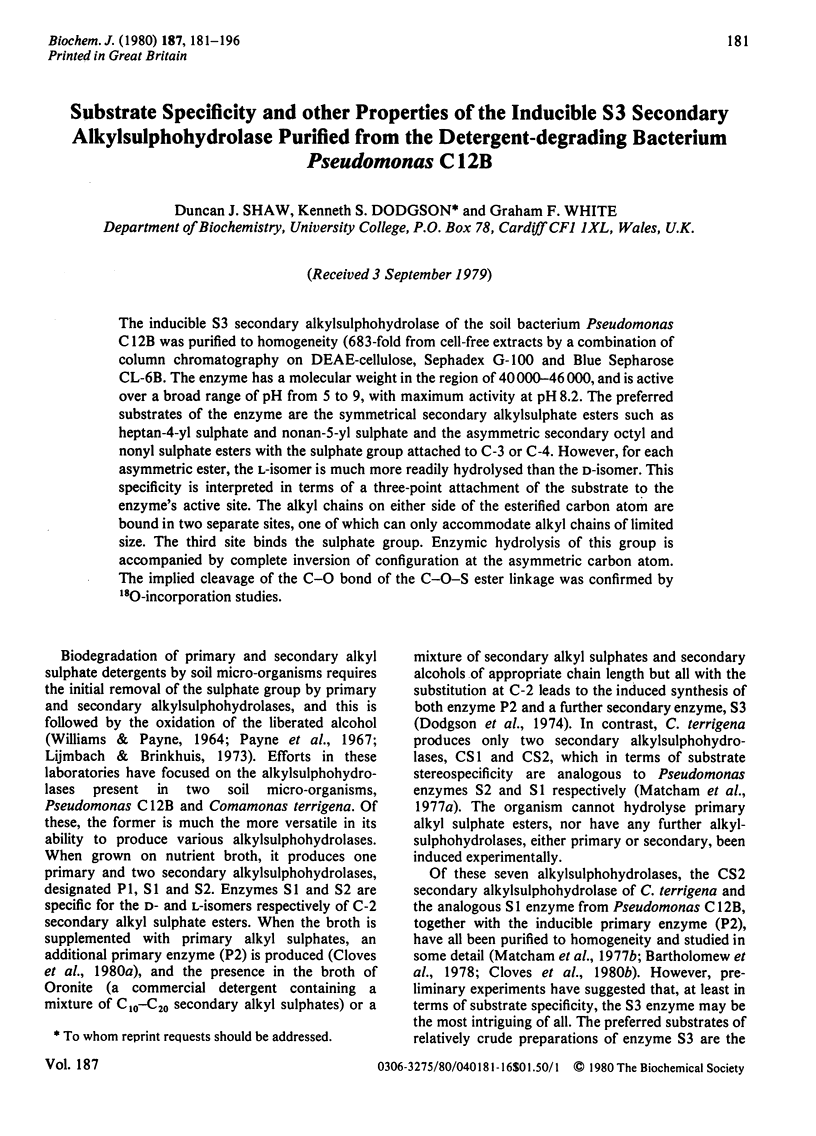
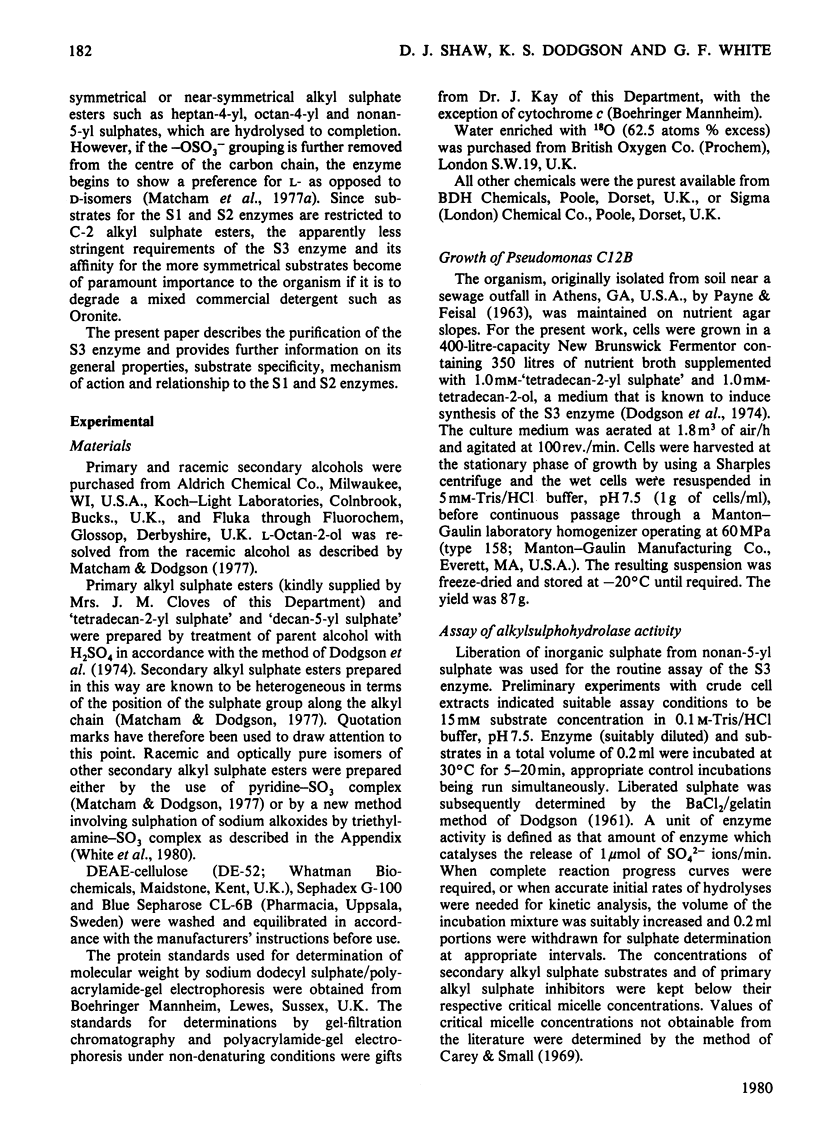

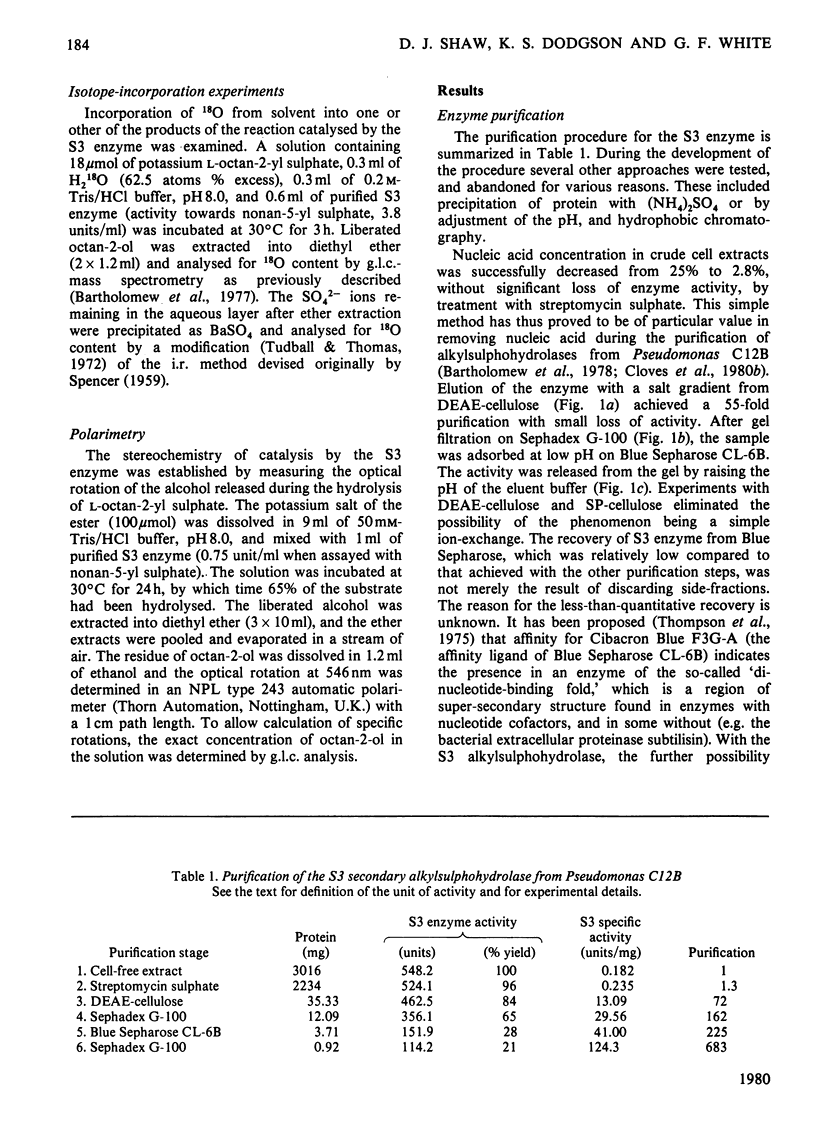




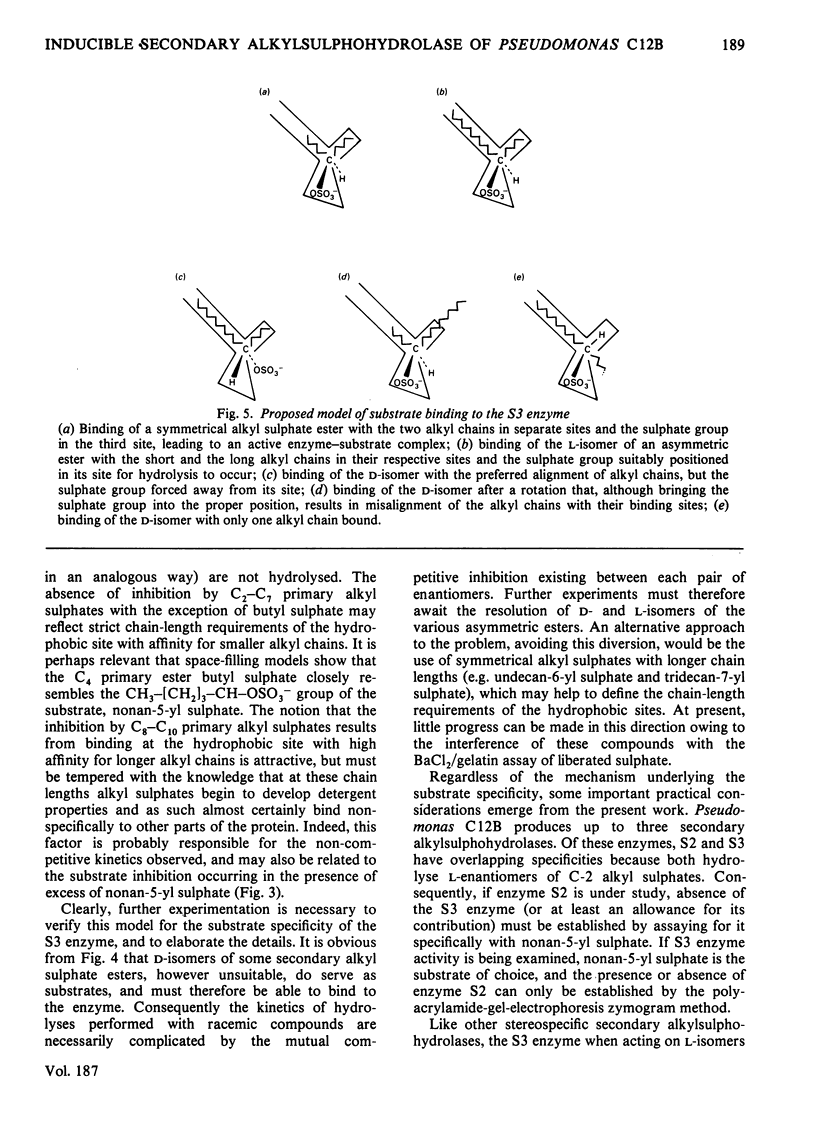
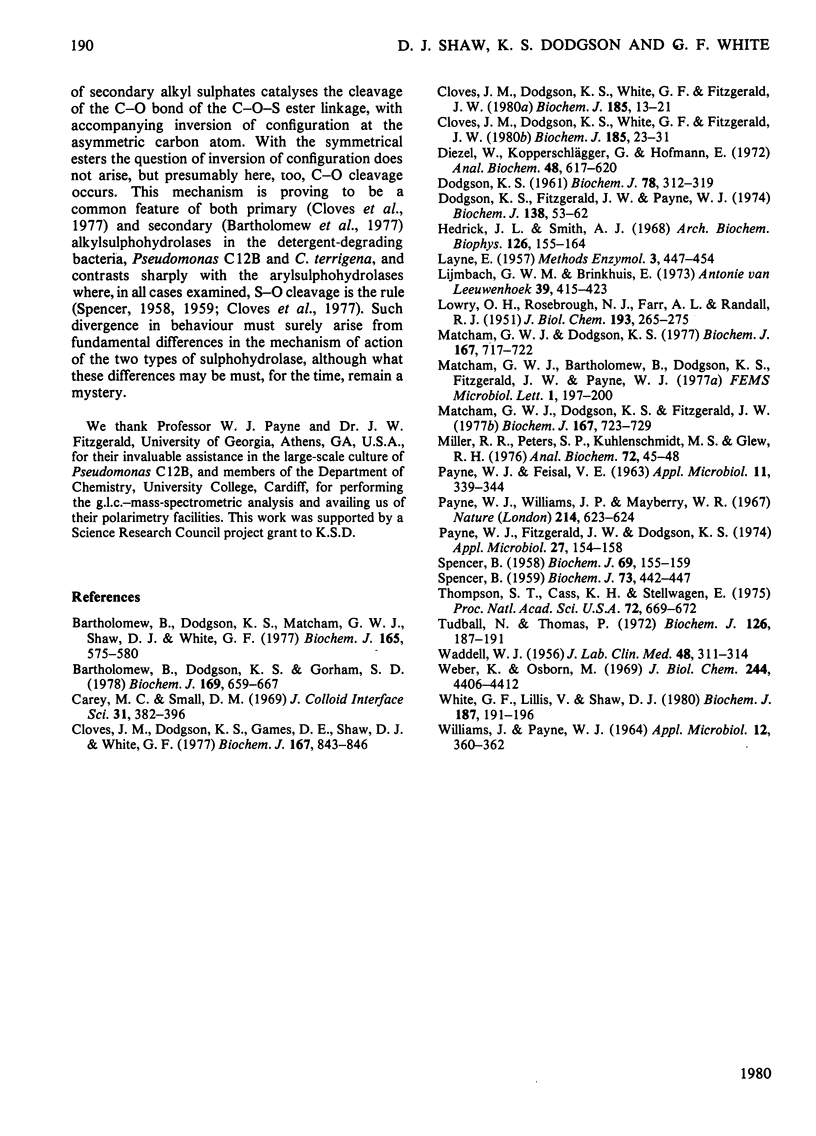
Selected References
These references are in PubMed. This may not be the complete list of references from this article.
- Bartholomew B., Dodgson K. S., Gorham S. D. Purification and properties of the S1 secondary alkylsulphohydrolase of the detergent-degrading micro-organism, Pseudomonas C12B. Biochem J. 1978 Mar 1;169(3):659–667. doi: 10.1042/bj1690659. [DOI] [PMC free article] [PubMed] [Google Scholar]
- Bartholomew B., Dodgson K. S., Matcham G. W., Shaw D. J., White G. F. A novel mechanism of enzymic ester hydrolysis. Inversion of configuration and carbon-oxygen bond cleavage by secondary alkylsulphohydrolases from detergent-degrading micro-organisms. Biochem J. 1977 Sep 1;165(3):575–580. doi: 10.1042/bj1650575. [DOI] [PMC free article] [PubMed] [Google Scholar]
- Carey M. C., Small D. M. Micellar properties of dihydroxy and trihydroxy bile salts: effects of counterion and temperature. J Colloid Interface Sci. 1969 Nov;31(3):382–396. doi: 10.1016/0021-9797(69)90181-7. [DOI] [PubMed] [Google Scholar]
- Cloves J. M., Dodgson K. S., Games D. E., Shaw D. J., White G. F. The mechanism of action of primary alkylsulphohydrolase and arylsulphohydrolase from a detergent-degrading micro-organism. Biochem J. 1977 Dec 1;167(3):843–846. doi: 10.1042/bj1670843. [DOI] [PMC free article] [PubMed] [Google Scholar]
- Cloves J. M., Dodgson K. S., White G. F., Fitzgerald J. W. Purification and properties of the P2 primary alkylsulphohydrolase of the detergent-degrading bacterium pseudomonas C12B. Biochem J. 1980 Jan 1;185(1):23–31. doi: 10.1042/bj1850023. [DOI] [PMC free article] [PubMed] [Google Scholar]
- Cloves J. M., Dodgson K. S., White G. F., Fitzgerald J. W. Specificity of P2 primary alkylsulphohydrolase induction in the detergent-degrading bacterium Pseudomonas C12B. Effects of alkanesulphonates, alkyl sulphates and other related compounds. Biochem J. 1980 Jan 1;185(1):13–21. doi: 10.1042/bj1850013. [DOI] [PMC free article] [PubMed] [Google Scholar]
- DODGSON K. S. Determination of inorganic sulphate in studies on the enzymic and non-enzymic hydrolysis of carbohydrate and other sulphate esters. Biochem J. 1961 Feb;78:312–319. doi: 10.1042/bj0780312. [DOI] [PMC free article] [PubMed] [Google Scholar]
- Diezel W., Kopperschläger G., Hofmann E. An improved procedure for protein staining in polyacrylamide gels with a new type of Coomassie Brilliant Blue. Anal Biochem. 1972 Aug;48(2):617–620. doi: 10.1016/0003-2697(72)90117-0. [DOI] [PubMed] [Google Scholar]
- Dodgson K. S., Fitzgerald J. W., Payne W. J. Chemically defined inducers of alkylsulphatases present in Pseudomonas C12B. Biochem J. 1974 Jan;138(1):53–62. doi: 10.1042/bj1380053. [DOI] [PMC free article] [PubMed] [Google Scholar]
- Hedrick J. L., Smith A. J. Size and charge isomer separation and estimation of molecular weights of proteins by disc gel electrophoresis. Arch Biochem Biophys. 1968 Jul;126(1):155–164. doi: 10.1016/0003-9861(68)90569-9. [DOI] [PubMed] [Google Scholar]
- Lijmbach G. W., Brinkhuis E. Microbial degradation of secondary n-alkyl sulfates and secondary alkanols. Antonie Van Leeuwenhoek. 1973;39(3):415–423. doi: 10.1007/BF02578884. [DOI] [PubMed] [Google Scholar]
- Matcham G. W., Dodgson K. S. Preparation and characterization of substrates suitable for the study of stereospecific secondary alkylsulphohydrolases of detergent-degrading micro-organisms. Biochem J. 1977 Dec 1;167(3):717–722. doi: 10.1042/bj1670717. [DOI] [PMC free article] [PubMed] [Google Scholar]
- Matcham G. W., Dodgson K. S. Purification, properties and cellular localization of the stereospecific CS2 secondary alkylsulphohydrolase of Comamonas terrigena. Biochem J. 1977 Dec 1;167(3):723–729. doi: 10.1042/bj1670723. [DOI] [PMC free article] [PubMed] [Google Scholar]
- Miller R. R., Peters S. P., Kuhlenschmidt M. S., Glew R. H. The use of ion-exchange resins in the application of protein samples to gel filtration columns. Anal Biochem. 1976 May 7;72:45–48. doi: 10.1016/0003-2697(76)90504-2. [DOI] [PubMed] [Google Scholar]
- PAYNE W. J., FEISAL V. E. Bacterial utilization of dodecyl sulfate and dodecyl benzene sulfonate. Appl Microbiol. 1963 Jul;11:339–344. doi: 10.1128/am.11.4.339-344.1963. [DOI] [PMC free article] [PubMed] [Google Scholar]
- Payne W. J., Fitzgerald J. W., Dodgson K. S. Methods for visualization of enzymes in polyacrylamide gels. Appl Microbiol. 1974 Jan;27(1):154–158. doi: 10.1128/am.27.1.154-158.1974. [DOI] [PMC free article] [PubMed] [Google Scholar]
- SPENCER B. Studies on sulphatases. 20. Enzymic cleavage of aryl hydrogen sulphates in the presence of H218O. Biochem J. 1958 May;69(1):155–159. doi: 10.1042/bj0690155. [DOI] [PMC free article] [PubMed] [Google Scholar]
- Spencer B. Studies on sulphatases. 25. The determination of BaSO(3)O by infrared spectroscopy. Biochem J. 1959 Nov;73(3):442–447. doi: 10.1042/bj0730442. [DOI] [PMC free article] [PubMed] [Google Scholar]
- Thompson S. T., Cass K. H., Stellwagen E. Blue dextran-sepharose: an affinity column for the dinucleotide fold in proteins. Proc Natl Acad Sci U S A. 1975 Feb;72(2):669–672. doi: 10.1073/pnas.72.2.669. [DOI] [PMC free article] [PubMed] [Google Scholar]
- Tudball N., Thomas P. The enzymic degradation of L-serine O-sulphate by a specific system from pig liver. Studies on the mechanism of the reaction. Biochem J. 1972 Jan;126(1):187–191. doi: 10.1042/bj1260187. [DOI] [PMC free article] [PubMed] [Google Scholar]
- WADDELL W. J. A simple ultraviolet spectrophotometric method for the determination of protein. J Lab Clin Med. 1956 Aug;48(2):311–314. [PubMed] [Google Scholar]
- WILLIAMS J., PAYNE W. J. ENZYMES INDUCED IN A BACTERIUM BY GROWTH ON SODIUM DODECYL SULFATE. Appl Microbiol. 1964 Jul;12:360–362. doi: 10.1128/am.12.4.360-362.1964. [DOI] [PMC free article] [PubMed] [Google Scholar]
- Weber K., Osborn M. The reliability of molecular weight determinations by dodecyl sulfate-polyacrylamide gel electrophoresis. J Biol Chem. 1969 Aug 25;244(16):4406–4412. [PubMed] [Google Scholar]
- White G. F., Lillis V., Shaw D. J. An improved procedure for the preparation of alkyl sulphate esters suitable for the study of secondary alkylsulphohydrolase enzymes. Biochem J. 1980 Apr 1;187(1):191–196. doi: 10.1042/bj1870191. [DOI] [PMC free article] [PubMed] [Google Scholar]


